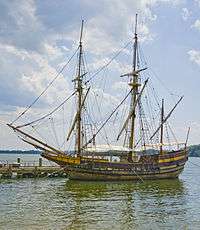Maryland Dove
 The replica 17th Century English merchantmen pinnace "Maryland Dove" at St. Mary's City, Maryland, constructed for state 350th Anniversary, 1975-1978. | |
| History | |
|---|---|
| Name: | "Maryland Dove" |
| Owner: | State of Maryland |
| Operator: | Historic St. Mary's City Commission |
| Ordered: | 1975 |
| Builder: | James B. Richardson, shipyard, Cambridge, Dorchester County, Maryland |
| Laid down: | 1975 |
| Launched: | August 14, 1978 |
| Commissioned: | October 8, 1978 |
| General characteristics | |
| Tons burthen: | 40 |
| Length: | 76 feet (23 meters) overall, and 56 ft (17 m) on deck. |
| Beam: | 17 ft (5.2 m) |
| Draft: | 7 ft (2.1 m) |
| Propulsion: |
|
"Maryland Dove" is a re-creation/replica of a late 17th century English trading ship, one of two ships which made up the first expedition from England to the Province of Maryland. The modern "Dove" was designed by the naval architect and naval historian William A. Baker.
The Dove
Launched in 1978, Maryland Dove is 56 feet in length on deck, and 76 feet overall with a displacement of 42 tons. She was built by James B. Richardson in a shipyard near Cambridge, Maryland in Dorchester County. Her home port is St. Mary's City, Maryland. The ship is owned by the State of Maryland and operated/maintained by the Historic St. Mary's City Commission. She was commissioned by Governor Harry R. Hughes for the 1982-1984 celebration of the 350th Anniversary of the settling of the Province of Maryland.
"The Ark" and "The Dove"
The first expedition from England to the planned colony of Maryland was undertaken by Cecilius Calvert, 2nd Baron Baltimore, (1605-1675), and consisted of two ships that had formerly belonged to Baltimore's father, Sir George Calvert, second Baron and Lord Baltimore, (1579-1632), "The Ark" and "The Dove".[1] The two ships departed Gravesend, in Kent off the English Channel, with 128 settlers on board and, after being chased down and brought back by the British Royal Navy so that the departing settlers could take an oath of allegiance to the King of England as required by law, sailed in October 1632 for the Isle of Wight (between England and France) to pick up more settlers.[1]
At the Isle of Wight "The Dove" and her larger sister ship "The Ark" embarked again with two Jesuit (Society of Jesus) priests/chaplains and nearly two hundred more settlers before setting out across the Atlantic.[2] Since he could not lead the expedition himself, Cecilius Calvert, Lord Baltimore sent detailed instructions for the governance of the Colony, including commands that his brothers seek any information about those who had earlier tried to thwart the granting of the colony and make contact with William Claiborne (previously settled from Province of Virginia on Kent Island in the middle of the Chesapeake Bay) to determine his intentions for the trading station on Kent Island.[3] The instructions also emphasized the importance of religious toleration among the colonists, who were nearly equal parts Catholic and Protestant.[3] With these last instructions, the expedition sailed for the Americas.

The two ships arrived at Point Comfort at the mouths of the James, Nansemond, and Elizabeth Rivers, in Virginia, February 24, 1634. On March 25, they landed at what is now St. Mary's, then the site of a Native American village, and they began the work of establishing a settlement there.[4] The settlement of St. Mary's was built on land purchased from the native Yaocomico.[5]
Back in England, Baltimore could do little to help the young colony through its tribulations, which included an ongoing feud with Claiborne that led to a series of naval skirmishes.[6]
Lord Baltimore continued as Maryland's first Proprietary Governor (1632–1675), and attempted to maintain an active involvement in the governance of the colony, though he never visited it. During this long tenure, he governed through deputies, the last being his only son Charles.
Notes
- 1 2 Browne, Page 40
- ↑ Browne, Page 45
- 1 2 Browne, Pages 46-57
- ↑
 This article incorporates text from a publication now in the public domain: Herbermann, Charles, ed. (1913). "article name needed". Catholic Encyclopedia. New York: Robert Appleton.
This article incorporates text from a publication now in the public domain: Herbermann, Charles, ed. (1913). "article name needed". Catholic Encyclopedia. New York: Robert Appleton. - ↑ Browne, Pages 59-62
- ↑ Browne, Pages 62-64
See also
References
- Browne, William Hand (1890). George Calvert and Cecilius Calvert: Barons Baltimore of Baltimore. New York: Dodd, Mead, and Company.
External links
- Historic St. Mary's City - official site
- Maryland Dove facts page Retrieved August 4, 2010
- showing a photo of the Dove Retrieved August 4, 2010
- The Dove at riverexploer.com Retrieved August 4, 2010
Coordinates: 38°11′08″N 76°26′07″W / 38.18556°N 76.43528°W